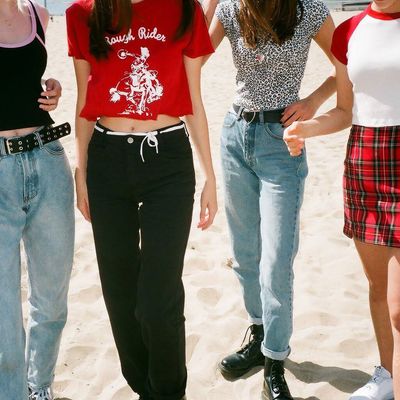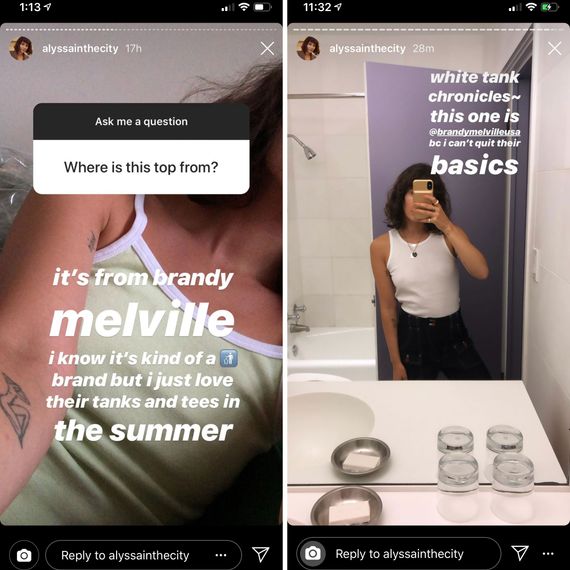
Alyssa Coscarelli is a sunny Instagram influencer in her late 20s — a former Refinery29 employee who is flown to various fashion weeks and tends to dress in downtown-ish brands like Maryam Nassir Zadeh, or Sandy Liang. This summer, she posted a picture of herself in a ribbed tank top from, of all places, the teen-girl chain Brandy Melville. “I just love their tanks and tees,” she wrote. “Though I know it’s kind of a [emoji of a trash can] brand.”
What you know about Brandy Melville depends on who you are. If you’re a teen mall girl, it’s an obvious place to buy shrunken, deeply inexpensive, decidedly Gen Z clothing. If you’re someone who reads a lot of Twitter, you might know it from headlines like “Brandy Melville Epitomizes What Is Wrong With Our Society,” which tend to pop up every six months thanks to its tightly conscribed size range and lack of diversity, both in its stores and online. But if you’re a millennial with connections to the fashion world, it might be the place where you’re shopping when no one is looking. There’s a growing cult of genuinely stylish, slightly abashed 20- and even 30-somethings turning to the brand for nostalgic, low-commitment (hardly anything is priced over $35) spaghetti-strap dresses and tube tops that would look as natural on Bella Hadid today as they would on Simple Life–era Paris Hilton.
Carmen Rosey Hall, a writer at Vogue, buys legions of the brand’s tiny, babydoll tees (“so many of them,” she says. “My guiltiest pleasure.”). Alison Chemla, the founder of fashion-girl favorite jewelry line Alison Lou, is a fervent, vocal fan of Brandy Melville’s Regina George–esque sweatpants. And Eden Deering, a curator at the Chelsea gallery P.P.O.W., buys Brandy Melville tube tops en masse (“only after 6 p.m.,” she says “so no one I know who works in Soho will see me”).
Then there’s Lauren Servideo, a 27-year-old comic Vogue dubbed the Funniest Person on Instagram. She’s been posting a series of videos of herself posing in Brandy tops, pretending to be one of the disaffected teens that tend to work in the stores. (“The number of times I’ve left that store questioning how well I know myself,” responded one of her followers, herself a nearly 30-year-old woman).
Or take Dasha Nekrasova, the 27-year-old provocateur, actress, and host of cultural commentary podcast Red Scare. Nekrasova, who might be best described as fashion-adjacent (she recently signed as a model, and walked in Rachel Comey and Eckhaus Latta’s Spring 2019 shows) posted a string of Brandy Melville-related tweets last July. First, she mused: “Brandy Melville is really doing something right.” Then, later, around 3am: “Did I talk about Brandy Melville too much at the party?” (The New Yorker writer Naomi Fry responded: “No.”) A few weeks later, Nekrasova spoke once again about the brand in an interview chronicling her shopping habits. “I know it’s essentially fascistic that everything is one size,” she says, referring to Brandy Melville’s so-called “one-size-fits-all” policy (predictably, the clothes really only fit all thin people). “But I feel euphoric in there.”
Brandy Melville, which was founded in Italy in the early ’80s, opened its first U.S. location in Westwood in 2009. It was an immediate hit with teens across the country (“What girl, from the age of 12 on, doesn’t include Brandy in her wardrobe?” opined self-describes “teen fashion enthusiast” Lani Renaldo in a HuffPost article in 2014). Which makes sense: The brand’s product-research team is (quite brilliantly) made up exclusively of Malibu-based teenage girls, the prices are low, and the aesthetic is aspirational but with an emphasis on teen authenticity (they don’t advertise or use professional models — instead, they flood their Instagram account with pictures of their skinniest, most long-legged, long-haired customers).
In the ten or so years since the first store opened, Brandy Melville has continued to thrive (according to the Fashion Law, the privately held company likely brought in somewhere around $300 million in 2018) despite near-constant reports about unethical practices. A quick scan on Glassdoor, a review site for companies, reveals that hundreds of former Brandy employees have complained of discriminatory practices around hiring, firing, and pay. “Your pay rate is 100% determined by your appearance,” wrote one woman, who worked as a salesgirl at the Westwood location for over three years. “You will get fired for gaining weight or cutting your hair,” wrote another. Said a third, plainly: “You will not get hired at a Brandy store if you’re black.”
Then there’s the brand’s bizarre fascination with Ayn Rand. Brandy’s (now shuttered) sister brand was called John Galt (a character in Atlas Shrugged), and for years, Brandy Melville stores sold T-shirts printed with quotes attributed to the author. Early stores apparently sold copies of Atlas Shrugged, Commentary magazine, and publications from the Heritage Foundation and Cato Institute — a little libertarian, freedom-of-choice ideology slipped ironically in between lavender bike shorts and plaid miniskirts that only come in a single size.
Still, despite the fact that the brand is shamelessly politically incorrect, apparently obsessed with objectivism, and decorates its stores with signs that read things like “Dat Shit Cray,” its cult of discerning adult fans continues to grow. On one level, the appeal is obvious — it’s cute, nostalgic, and cheap. Coscarelli says, “They make ideal ’90s-ish throwback pieces you never really find at vintage stores but wish you could: baby tees, cropped plaid pants, mini skirts, spaghetti-strap tanks,” she says. But for those who are aware of the brand’s bad politics and business practices, wearing it is complicated: It’s an in-joke that’s not really a joke, because you’re still giving them money. Talking about it in public, or on social media, is a way of easing the discomfort of shopping there.
For Servideo, it seems, there’s a sort of ironic pleasure in wearing clothing aimed at teens as an adult woman. In one of her videos, she wears an ill-fitting Brandy sweater and Brandy pants that won’t close at the waist. “My mom says I can get my bellybutton pierced,” she intones, looking at the camera. Then: “My boyfriend goes to a different high school — he has his learner’s permit.” For Nekrasova, who is obstinately anti-PC-everything, there’s a sort of edgelord posturing; it’s subversive to associate yourself publicly with a company that’s so unreservedly unconcerned with inclusive sizing, or rejecting far-right ideology, or fair labor practices. And for some people, it’s a subtle brag: You have to be thin in order to get away with wearing one-size-fits-all clothing, when the one size is XS.
And then there’s the brand’s intangible throwback affect. Between the ‘90s styling, the pre-woke politics, and the literal cabal of teen girls deciding what’s cool and what’s not, stepping into a Brandy Melville store is like stepping back in time. Which points to another mall brand that millennials love to talk about.
“They remind me so much of Abercrombie, where everyone my age shopped, or wanted to shop at, in middle school,” says Servideo. “The girls working there are beautiful and 14, and cultivate this intentionally casual environment — they say ‘what’s up,’ instead of ‘welcome to Brandy Melville.’ That’s the exact same thing they did there — ‘what’s up’ with this bored stare. They evoke a memory of our generation.”
The irony, of course, is that the more you post about how embarrassed you are about shopping at Brandy, the more you discover who else is shopping at Brandy. A couple of weeks ago, Servideo messaged her friend Summer Dawn — a late-20s influencer and stylist at the luxury clothing department store the Webster — to ask her where she got her tank top from. “She responded, ‘Are you okay in the head, sis? It’s obviously Brandy Melville.’”


